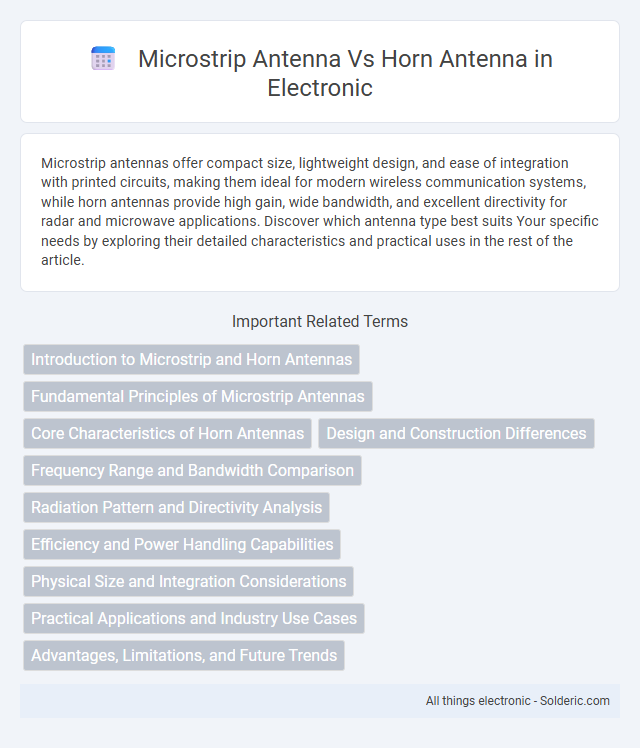Microstrip antennas offer compact size, lightweight design, and ease of integration with printed circuits, making them ideal for modern wireless communication systems, while horn antennas provide high gain, wide bandwidth, and excellent directivity for radar and microwave applications. Discover which antenna type best suits Your specific needs by exploring their detailed characteristics and practical uses in the rest of the article.
Comparison Table
| Feature | Microstrip Antenna | Horn Antenna |
|---|---|---|
| Structure | Flat, printed on a dielectric substrate | Flared metal waveguide |
| Size | Compact and lightweight | Large and bulky |
| Frequency Range | GHz range (e.g., 1-40 GHz) | Microwave to millimeter wave (1 GHz to 100+ GHz) |
| Gain | Low to moderate (5-9 dBi) | High (10-25 dBi) |
| Bandwidth | Narrow to moderate (few % to 10%) | Wide bandwidth (up to octave bandwidth) |
| Radiation Pattern | Broadside, directional | Highly directional with narrow beamwidth |
| Efficiency | Moderate to high, influenced by substrate losses | High efficiency |
| Cost | Low cost, easy to fabricate | Higher cost, complex manufacturing |
| Applications | Wireless communication, satellite TV, RFID | Radar, satellite communication, microwave links |
Introduction to Microstrip and Horn Antennas
Microstrip antennas consist of a flat metallic patch mounted on a dielectric substrate, offering a compact, lightweight, and low-profile design ideal for modern wireless communication systems. Horn antennas feature a flared metal waveguide that provides high gain and directivity, commonly used in radar and satellite applications. Both antenna types serve distinct purposes, with microstrip antennas excelling in integration and horn antennas in high-power and high-frequency transmission.
Fundamental Principles of Microstrip Antennas
Microstrip antennas operate based on the principle of electromagnetic wave radiation from a patch conductor printed on a dielectric substrate above a ground plane, creating a resonant cavity that supports radiating modes. Their operation relies on the transmission line model and cavity model to analyze impedance and radiation characteristics, enabling compact, low-profile designs suitable for planar integration. The fundamental mechanism involves fringing fields at the patch edges that produce directional radiation patterns, making microstrip antennas ideal for modern wireless communication systems.
Core Characteristics of Horn Antennas
Horn antennas exhibit a flared metal waveguide structure that efficiently directs radio waves, providing high gain and wide bandwidth performance. Their core characteristics include a well-defined radiation pattern with low side lobes and excellent directivity, making them ideal for point-to-point microwave communication and radar applications. The robust design and broadband operation ensure minimal signal distortion and superior power handling compared to microstrip antennas.
Design and Construction Differences
Microstrip antennas consist of a flat metallic patch on a grounded substrate, offering a compact, lightweight design ideal for integration with printed circuit boards. Horn antennas feature a flared metal waveguide structure that provides high gain and directivity but results in a larger, bulkier form factor. Your choice depends on whether you prioritize compactness and ease of fabrication or higher performance and wider bandwidth.
Frequency Range and Bandwidth Comparison
Microstrip antennas typically operate within the GHz frequency range, offering moderate bandwidths suitable for wireless communication and radar systems, whereas horn antennas cover a broader frequency spectrum from hundreds of MHz to tens of GHz, providing significantly wider bandwidth capabilities. The limited bandwidth of microstrip antennas often requires careful design considerations or additional structures like impedance matching layers to enhance performance. Your choice between these two antenna types depends on the specific frequency requirements and bandwidth constraints of your application.
Radiation Pattern and Directivity Analysis
Microstrip antennas typically exhibit a broad radiation pattern with lower directivity, making them suitable for applications requiring wide-angle coverage and compact form factors. In contrast, horn antennas generate highly directional radiation patterns with significantly higher directivity, providing focused energy transmission ideal for long-range and high-gain applications. The directivity of horn antennas can exceed 20 dBi, whereas microstrip antennas often achieve directivity values around 6 to 9 dBi depending on the design parameters.
Efficiency and Power Handling Capabilities
Microstrip antennas typically exhibit lower efficiency due to substrate losses and limited power handling capacity, making them suitable for low to moderate power applications. Horn antennas offer high efficiency with minimal insertion loss and can handle significantly higher power levels, making them ideal for high-power microwave transmissions. The choice between these antennas depends on application requirements, balancing efficiency and power handling capabilities.
Physical Size and Integration Considerations
Microstrip antennas feature compact, low-profile designs ideal for integration into printed circuit boards and conformal surfaces, making them suitable for space-constrained applications. Horn antennas, however, exhibit larger and bulkier structures that limit integration flexibility but provide higher gain and directivity. The choice between these antennas often hinges on the need for miniaturization versus performance requirements in system design.
Practical Applications and Industry Use Cases
Microstrip antennas are widely used in mobile communication devices, satellite systems, and radar applications due to their low profile, lightweight, and ease of integration with printed circuit boards. Horn antennas find extensive applications in microwave communication links, radio astronomy, and radar systems where high gain and directivity are crucial. The microstrip antenna's compact size suits consumer electronics and automotive radar, while horn antennas are preferred in industrial testing and measurement systems requiring robust performance at high frequencies.
Advantages, Limitations, and Future Trends
Microstrip antennas offer compact size, low profile, and ease of integration with printed circuit boards, making them ideal for mobile and wearable devices, but they face limitations in bandwidth and power handling compared to horn antennas. Horn antennas provide high gain, wide bandwidth, and excellent directivity, suitable for radar and satellite communications, yet their bulky structure and manufacturing complexity restrict portability and mass deployment. Future trends in antenna technology focus on hybrid designs combining microstrip flexibility with horn performance, advanced materials like metamaterials for bandwidth enhancement, and smart antennas with adaptive beamforming to optimize Your wireless communication systems.
microstrip antenna vs horn antenna Infographic

 solderic.com
solderic.com